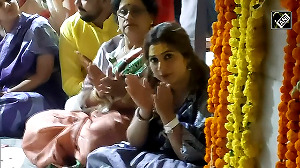Is Indian advertising getting comfortable with the greys of life?
In the latest Sprite commercial, a guy two-timing his girlfriend confesses with honesty that he is late because he was with another girl. The second girlfriend doesn't believe it because he says it with such a straight face that she thinks he is lying -- pulling her leg!
In the new MotoYuva commercial, the son insolently turns on the music in his mobile when his father slams him for irresponsible behaviour and asks him to grow up.
In a Virgin mobile commercial, a 'cute' daughter hints to her parents that she swings the other way. Her parents panic. So, when a 'boy' friend from another religion invites her for a weekend picnic, her father encourages her to go out. She, thus, uses deception to get parental permission.
A year and a half ago, a Five Star commercial has a teenage girl hiding her boyfriend in the loft of her house as her parents unexpectedly come home while she and he are having a good time at her house.
Brand builders will still call all this 'irreverence of the youth' -- but deep down new values are seeping into the brand world -- unfaithfulness, insolence, and deception. Indian advertising is today seeing a set of ads where brand protagonists are no longer all pure and are quietly exposing their shades of grey. Unconsciously, they are getting real!
We, Indians, are historically comfortable with blacks and whites rather than greys, especially in popular culture. When Hollywood movies are adapted into Bollywood screenplays, the 'reality' of characters is often chiselled out to make them either pure heroes or villains -- the good guy or the bad guy. If a hero is doing something wrong, he is always enveloped with a story about a larger cause -- an ailing family member or a wronged parent -- and hence always depicted as fundamentally good.
For example, when 'Sabrina' was made into Yeh Dillagi the elder brother's -- Harrison Ford -- mean business streak in the English version was removed to make Akshay Kumar -- the Hindi protagonist -- the all 'white' responsible elder son. Though Hindu mythology has two main heroes -- Rama the upright, Sampoorna Purushottam, and Krishna the more real human -- it is Rama, in his completeness, who dominates Indian culture.
Brands have always been comfortable with good values. So, often in the marketing world, when you read brand personalities and values, they sound like a collection of virtues that everyone wants to have and they often end up defining characters who seem fictitious -- almost hypothetical!
Even if the darker side of society is used, it's more often where the 'brand' is the do-gooder -- consciously or unconsciously -- rightfully resolving the not-so-good situation. For example, a few years ago M-seal -- a sealant from Pidilite -- revealed the darker side of families and wills in its commercial. A greedy son gets his father, on the dying bed, to add a couple of more zeroes to what he is bequeathing him in his will. However, a drop of water from a leaking roof smudges the 'one' at the beginning leaving our 'villain' penniless.
In two other interesting recent commercials -- Tata Tea and Idea -- the protagonists reveal the darker side of society and the brand is the partner in either bringing up the issue or resolving it. In Tata Tea, the common man questions a prospective candidate's credentials to do the job of running the country; in the Idea commercial, the small 'B' actually says that mobile numbers and not names will now define people in a village! Dark sides are treaded but only towards the end of victory for the brand.
The truth is that there is a darker side to each one of us that makes us human. It co-exists with the good side. There is also pleasure in doing 'wrong' things and for survival in the real world, it's often necessary to do them. Our social consciousness doesn't allow us to depict such things -- it seems that we are promoting 'bad' rituals and values. But if brands are to be real, there is a need to get real.
There was much debate years ago about a Surf campaign that showed kids splashing ink on each other in school. The brand arrives as the resolution -- kids can be kids without fear because with Surf, ink stains can be removed easily. Is this depiction of real life or is it unconsciously encouraging kids to behave badly? If parental objective is to get kids not to do this, then is it socially irresponsible for brands to 'legitimise' this in advertising -- especially given that children are impressionable.
Humphrey Appleby and Jim Hacker in the 'Yes Prime Minister' series are epitome of characters who lead real lives dealing with real situations in a real manner. They inspire our admiration for -- both effectively and smartly -- resolving problems. Yet, brands in India, for sure, tend to be comfortable with 'effective' rather than 'smartness' as values. 'Shaanapan' will be depicted only when the protagonist is getting the better of either a pompous or a more powerful person.
Life is more complicated than being all good-goody. If products are about what is functionally delivered and brands are about role in life, then brands need to recognise the shades of grey and place brands in that context. Indian culture is dichotomous. There are no rights and wrongs in our world -- it's all in the context.
Yet, our heroes are all white or all black. We know little about the 'good deeds' done by Ravana and the Kauravas, or the 'bad deeds' of Rama or the Pandavas. Given the purity of our role models, we carry them into our today's world. We deify easily, we vilify equally easily. Our cricketers are heroes when they win; they become zeroes when they lose -- all judgments in extremities.
In this context, it is rather brave to see brands venturing into territories that show protagonists as real. It's a reflection of both creators coming out of their 'traditional' thinking shells and consumers (if accepted widely) getting more accepting of reality.
Karan Johar's Kabhi Alvida Na Kehna, to my mind, was a landmark in its own right. It was a commercial film that depicted reality in an unreal world. It had a hero who is seen as everyone's 'son' actually legitimising infidelity. It had an elderly superstar seen as everyone's parent actually asking a daughter-in-law to leave his son. It had a woman seen as everyone's bahu actually going out of marriage for love. It portrayed real life and yet projected very progressive thinking and values. Not surprisingly, it stirred much debate and got rejected by the masses -- even the westernised multiplex audiences. Are Indians ready to accept the greys of life? And, if yes, how much?
Something worth thinking about.
The author is Country Head, Discovery and Planning.







 © 2025
© 2025